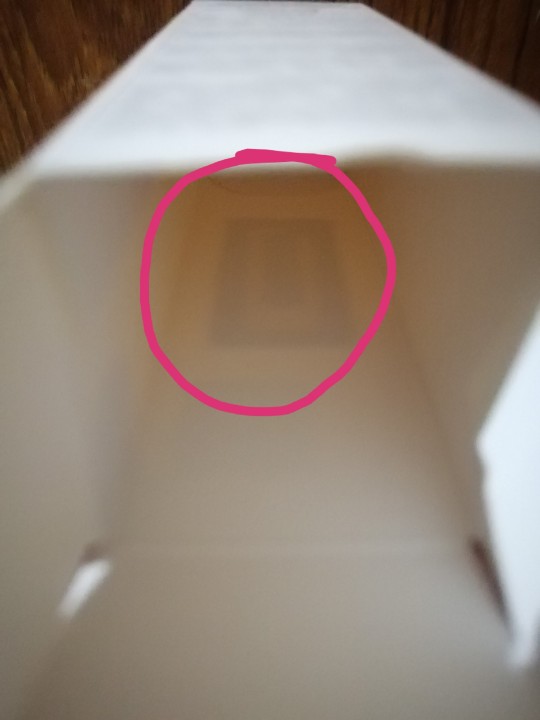#RFID
Text
Mandatory RFID chips to track all cattle in the USA
#RFID#Food Security#Advocate for Agriculture#Support Local Farmers#No Farms - No Food#No Farmers - No Food - No Future#Like Minded People#Make Tumblr ★ Great Again
80 notes
·
View notes
Text

rfid INSIDE the box of a 0.99$ face serum
41 notes
·
View notes
Text
MultiBlade I.A. - Corte Digital Inteligente e Automático para FILAS de TRABALHOS em Rótulos💡 Saiba mais: https://www.apolo.com.br/MULTIBLADE-IA 📞 WhatsApp (11) 3164-9400 💬 Link: https://www.apolo.com.br/WhatsApp
Descubra a revolução em corte de rótulos e etiquetas com a MultiBlade 330 I.A. – sua solução tudo-em-um para acabamento digital de alta precisão. Equipada com tecnologia de Inteligência Artificial, esta máquina identifica e corta imagens automaticamente com velocidade de até 8 m/min, sem desperdícios. Seu sistema de corte com lâminas de baixo custo é ideal para qualquer formato complexo, oferecendo acabamentos profissionais sob demanda.
A MultiBlade 330 I.A. não apenas maximiza a eficiência e a qualidade, mas também reduz significativamente os custos e o tempo de produção, eliminando a necessidade de matrizes físicas. Com capacidade para bobinas de até 450 mm de diâmetro e largura de 340 mm, adapta-se a uma ampla gama de materiais, garantindo cortes precisos e homogêneos que se encaixam perfeitamente em qualquer processo de rotulagem.
Sua operação é simplificada pelo alinhador de banda ultrassônico de alta precisão, que detecta e corrige desvios automaticamente, otimizando o processo de produção. Totalmente pneumática, compacta, e robusta, a MultiBlade 330 I.A. é projetada para ser intuitiva e fácil de usar, permitindo rápida troca de trabalhos e minimizando a necessidade de manutenção.
Transforme a maneira como você produz rótulos e etiquetas, economizando tempo e recursos, enquanto entrega produtos de qualidade superior que atendem exatamente às necessidades de seus clientes.
#design#packaging#printing#packagingdesign#digitalprinting#printingindustry#packagingsolutions#flexiblepackaging#offsetprinting#printingsolutions#flexo#labels#labelprinting#paper#embalagens#inkjetprinting#packagingideas#rfid#thermal#embalagem#prepress#grafica#producao#papel#labeling#packagedesign#customdesign#flexografia#labelexpo#uvprinting
2 notes
·
View notes
Text
Juni 2023
Museum zum Mitnehmen
Das Jüdische Museum in Frankfurt am Main wurde seit 2015 aufwendig erweitert und im Oktober 2020 wiedereröffnet. Bei meinem Besuch im Mai 2023 bekomme ich zusätzlich zur Eintrittskarte eine weitere Karte. Die Illustration zeigt Alt- und Neubau des Museums, das grüne Wellenmuster ist im Prägedruck ausgeführt. Die Karte steckt in einem Pappschuber.


Auf der Rückseite ist die Bedienungsanleitung aufgedruckt, aber die freundliche Dame an der Kasse erklärt mir das Prinzip auch noch einmal persönlich. In der Ausstellung gibt es Stationen, die mit dem „Museum to go“ Logo gekennzeichnet sind. Hält man die Karte auf das Logo, blinken die Leuchtdioden an der Station kurz auf als Bestätigung, dass die Daten auf die Karte übertragen wurden.
Die Museums-App mit dem Audioguide habe ich schon zuhause auf mein Mobiltelefon geladen, Kopfhörer habe ich inzwischen bei jedem Museumsbesuch dabei. Ich wähle einen Rundgang, der mich in 90 Minuten durch das Museum führt. Es gibt auch eine 60 Minuten-Tour, eine in leichter Sprache und eine in Gebärdensprache.
Das Mitnehmen funktioniert einwandfrei. Ich lade einen Film zur Emanzipation der Juden in Frankfurt auf die Karte, ein Rezept für Challa und das Apfelkuchenrezept der Tante von Anne Frank. Ein Datenspeicher befindet sich nicht auf der Karte, nur ein RFID Transponder. Am heimischen Rechner gebe ich auf der Museum to go-Internetseite den achtstelligen Code ein, der auf der Rückseite meiner Karte aufgedruckt ist. Ich werde auf eine Seite geleitet, die als erstes die Exponate anzeigt, die ich eingesammelt habe. Weiter unten werden auch die restlichen 18 to go-Inhalte aufgelistet. Ich muss mich also nicht grämen, etwas vergessen zu haben.
Warum die Karte nochmal in einem Pappschuber steckt, erschließt sich mir nicht ganz. Es lässt das Ganze wertiger erscheinen, aber nachhaltig ist so eine reine Designmaßnahme nicht. Die Hülle verdeckt den achtstelligen Abrufcode, der ganz und gar nicht geheim gehalten werden müsste. Die Internetseite zeigt sowieso alle to go-Inhalte an, der einzige Mehrwert ist, dass die von mir markierten Elemente nach oben sortiert sind.
Als letzter Punkt der Bedienungsanleitung steht auf dem Pappschuber: „Die Karte als Lesezeichen nutzen“. Das mache ich und dafür ist sie tatsächlich sehr nützlich.
(Marlene Etschmann)
11 notes
·
View notes
Text

Gesundheitsdaten in Gefahr
Sensible Daten müssen geschützt werden
Vor allem müssen sie möglichst nicht zentral gesammelt werden - am besten ist es natürlich, sie werden gar nicht erst erfasst. Immer wieder lesen wir Kommentare auf unsere Kritik an der elektronischen Patientenakte (ePA), dass es doch gut wäre, wenn man Doppeluntersuchungen vermeiden könnte und jederzeit auf alle für den Patienten erhobenen Daten zugreifen könnte.
Dazu müssen wir leider immer wieder feststellen:
Keine zentrale Datensammlung ist sicher. Das haben auch Hacker insbesondere für Gesundheitsdaten auf dem 37. CCC Kongress wieder unter Beweis gestellt (Gesundheitsdaten nur bedingt sicher ).
Mammut-IT-Projekte kosten Unsummen, bringen nur marginale Ergebnisse und erhöhen die Gefahr für unsere Daten (s. alle Berichte über die mehr als 6 Milliarden Euro für die eGK - eine Plastikkarte mit Foto).
Die für uns maximal zulässige Instanz für eine zentrale Sammlung wäre die eigene Krankenkasse. Hier könnte uns die Politik sogar entgegenkommen, wenn sie statt Hunderter Krankenkassen eine-für-alle schaffen würde, einschließlich der Privatversicherten.
Die Relevanz unserer Gesundheitsdaten für die Forschung nutzt vor allem den Pharmariesen.
Die Pseudonymisierung unserer Daten ist keine Anonymisierung und damit langfristig gefährlich.
Unsere Gesundheitsdaten sind überhaupt nicht relevant, da sie nur von den gesetzlich Versicherten stammen würden. Die Privatversicherten werden wieder einmal privilegiert behandelt.
Das ab heute zwingend gültige eRezept wird sicher nicht ab heute Standard, weil auch die Ärzte es nicht wollen.
Wir lehnen weiterhin jede Zwangsdigitalisierung ab, weil sie für viele das Leben schwerer anstatt leichter macht.
Wir verweisen auf einen offenen Brief, den ein Bündnis aus vierzehn zivilgesellschaftlichen Organisationen und Sicherheitsforscher, darunter CCC ebenso wie der Verbraucherzentrale Bundesverband, unter der Überschrift "Vertrauen lässt sich nicht verordnen" an die Verantwortlichen für unsere Gesundheitspoltik verschickt haben. Sie fordern darin, wie Heise.de berichtet, Korrekturen an den Plänen zur weiteren Digitalisierung des Gesundheitswesens, der Mensch sollte dabei im Zentrum stehen.
Kritisiert wird auch, dass künftig bei der Ausgestaltung des "Gesundheitsdatenraums" das Bundesamt für Sicherheit in der Informationstechnik und der Bundesbeauftragte für Datenschutz und die Informationsfreiheit lediglich "ins Benehmen gesetzt werden" sollen und kein echtes Mitspracherecht haben sollen. Auch die Patienten selbst sollen weitgehend außen vor bleiben. So ist bisher nirgends geplant, ihnen eine Nutzen, z.B. durch individuelle Informationen zu ihrem Gesundheitszustand, zukommen zu lassen, wenn die angeblich so wichtige Forschung mit ihren Gesundheitsdaten (lebens-) wichtige Ergebnisse bringen sollte.
Selbst eine Gemeinwohlorientierung der Forschungsergebnisse aus unseren Gesundheitsdaten ist nirgends festgeschrieben. Auch hier wird stattdessen nur Politik zur Gewinnmaximierung für die Pharmariesen gemacht.
Bei aller Kapitalismuskritik vergessen wir nicht die vielen Datenschutzmängel:
Alle unsere Artikel zu ePA+Datenverlusten https://www.aktion-freiheitstattangst.org/cgi-bin/searchart.pl?suche=ePA+verlust&sel=meta
Mehr dazu bei https://www.heise.de/news/Elektronische-Patientenakte-Zivligesellschaft-und-Sicherheitsforscher-warnen-9572354.html
Kategorie[21]: Unsere Themen in der Presse Short-Link dieser Seite: a-fsa.de/d/3yb
Link zu dieser Seite: https://www.aktion-freiheitstattangst.org/de/articles/8637-20240101-gesundheitsdaten-in-gefahr.html
#eGK#ePA#seconduse#Profit#Forschung#Lücke#Widerspruch#Verbraucherdatenschutz#Datenschutz#Datensicherheit#Freiwilligkeit#Zustimmung#Einwilligungserfordernis#elektronischePatientenakte#CCC#Skandale#RFID#elektronischeGesundheitskarte#eHealth#Zwangsdigitalisierung#Gematik
2 notes
·
View notes
Text
Kaisa's defense: Are patrons who borrow books, liable to return them?

Kaisa gets annoyed with the committee of Three Witches
Happy Book Lovers' Day! On December 16, 2020, I submitted a post to I Love Libraries about Kaisa, the recurring librarian in the animated series, Hilda, titled "Witches, patrons, and the value of libraries in Netflix's Hilda," and included a section, where Kaisa argues that the "person who borrowed the book is liable for its return," with the obligation passed from the librarian to the patron, while the witches say SHE is the one responsible. While this was included in the final article, which was published on January 8, 2021, and re-titled "The Mysterious Librarian in Netflix's "Hilda" Finally Gets a Name," it was worded differently, [1] and I didn't explore it in-depth. So I'll re-examine that part of the episode and note its implications more broadly in terms of relations between librarians and patrons, and the ever-present problem of missing books from libraries.
This post is reprinted from Pop Culture Library Review and Wayback Machine.
In the episode "Chapter 3: The Witch," Kaisa comes before three witches who govern the tower and they tell her that she must return a book missing from the library for almost 30 years! She challenges this, saying that the person who borrowed the book is liable for its return, passing off the obligation from the librarian to the patron. The witches remind her of her responsibilities and say that if she does not find the book, she will be cast into the void! While librarians obviously are not cast into the void for misplaced books, the episode is right to highlight the problem of missing books and how librarians solve this problem. Later, Kaisa reveals why she had not tried to return the book until now: she was embarrassed that she could not use the right spell to find the book. They later return with the book and Tildy pleads with the witches to not punish them, the void of no return is unintentionally opened, trapping Kaisa, Hilda, and Frida.
The question at the title of this post still itches my brain: Are patrons who borrow books, liable to return them? Some on /r/Libraries and /r/librarians have shared that they give students who fail to return a book a warning, the terrible condition of returned books(which is kinda funny to read), stolen/lost book, and lending to the wrong person. Others shared the return of missing items, horrible patrons, weird sense of guilt when checking out books, getting patrons to return their books, presenting photo IDs to check out books, and libraries that give anyone a library card. [2] One of the most interesting discussions was one on /r/asklibrarians where librarians responded as to how a librarian could cover up a theft:
...Books disappear all the time. Depends on if the library uses any security measures like RFID tags...Here are a few ideas: Checking the book out to another user. Marking it as lost under that other users identity. Checking the book in but just taking it. Makes it appear lost in the shelves. Simply taking the book through an employee entrance with no security gates. Or simply desensitizing the security strip and walking the book out the front door. Or you can purge the user from the system making them not exist. Assuming a modern library, the librarian could alter the records if they had the right circulation authorizations. In most cases, there is likely to be an audit trail, but no one is likely to be looking for that unless alerted to the possibility that someone did that. Someone with the right IT privileges for the circulation software, could probably alter those audit trails as well.
In some ways, Kaisa may have done this when not getting the book back from Tildy. She probably as had to deal with those who return books with "illegal drugs, water damage, urine odors, cigarette burns, coffee stains, fecal matter, roaches, or peanut butter globs," those who have tried to argue that they don't need to pay library fines, while dealing with account issues, checking out books, and other tasks. [3] As one librarian put it, not only can the length of a loan period " have a big impact on staff workload and patron satisfaction with a library," but overdue materials are an issue "because they are not available to other library users" while fines lead to the perception that overdue fines allows the library to function and buy materials.
In fact, many libraries spend a lot of money and time "attempting to retrieve overdue materials and collect various fines," meaning these fines represent "a drop in the bucket for library revenues" and saying that while overdue fines may "provide some incentive for returning materials" some studies have shown they are "not a significant deterrent to the ultimate return of items. Libraries can also collect fines on lost and damaged materials or lost library identification cards, which are meant to " replace or repair the material...plus a processing fee," while it was said that there "should be some flexibility with overdue policies." It has also been said that if a book is lost, then a fine should be collected, while for a missing book, "the library does not know where the item is." [4]
The same librarian urged library personnel to be "familiar with registration procedures and be prepared to answer questions about the library’s services and resources," and to have specific "procedures for dealing with security and medical emergencies and all staff should be thoroughly familiar with them." This connects with the mission of a librarian to not only handling books, but books themselves serving a vital function, and the responsibility of the library to "adjust the time allotted for the patron to have the item to ensure it reaches the originating library on time." It was also said that librarians should take into account copyright, freedom of information, privacy, duty of care, censorship, and confidentiality which assisting a patron. [5]

Committee of Witches annoyed with Kaisa
When it comes to actual libraries, there appears to be agreement with the idea that patrons who borrow books are liable to return them. In fact, of library policies I read, there was a consensus that patrons are responsible for book replacement, returning books on time (late books hinder ability of other patrons to use book), have to pay for damaged or lost materials, and responsible for books they have checked out under their name. [6] Some librarians even said that those who abuse privileges may be banned from interlibrary loan, holds placed on their student accounts, suspension of borrowing privileges, or being reported to a collection agency. [7]
There were libraries which laid out their responsibilities even more clearly. Some said they had the "responsibility of ensuring the availability of materials for the use of the community," but that the person who borrows materials is responsible for materials borrowed and "agrees to return them in good condition and by the date they are due." Others absolved the library from "liability, damages, or expense" from misuse of library devices, library materials, and asserted that librarians are responsible for renewing and returning items, with fees imposed if items are not returned. However, in some cases, librarians had the discretion to stop or restrict loans of materials or the ability to waive fines, charges, or fees in cases of hardship. [8]
Kaisa stands by her view that patrons who borrow books are liable to return them, while the witches say it should be the library's responsibility after a book is overdue for 30 years. If this was the real world, the responsibility of the patron would likely still be emphasized, but at that point, the library would have declared the book "lost" and probably charged the patron a fee for the lost book. Kaisa does not do that as she knows exactly who has the book, but she doesn't want to take responsibility for getting the book back, not at first.
The answer to the question, are patrons who borrow books, liable to return them, is generally yes, but that does not justify patrons being treated in such a way that they are heavily penalized with fines which discourage them from borrowing from a library. It is certainly a "wonderful surprise" that Kaisa is the keeper of the books, i.e. the librarian who, with the help of Hilda and Frida, was able to convince an old lady to return a book. An impressive feat, you could say.
© 2022 Burkely Hermann. All rights reserved.
Notes
[1] Worded as "the person who borrowed the book is responsible for it and the witches threaten to cast her into a void if she cannot locate the lost item."
[2] See the "checking out books" (Nov. 2018), "Librarians: What's the worst condition someone has returned a book?" (Apr. 2014), "Most stolen book at your library" (Jul. 2018),"I (accudentally) lent a book to someone who is NOT authorized to use the library. What to do?" (Jun. 2020), "Lots of (probably) missing items were returned!" (Nov. 2020), "Horrible Patrons: CoVid Edition" (Feb. 2021), "I'm struggling with a weird sense of guilt when checking books out now, it's very irrational" (Sept. 2021), "Academic librarians: strategies for getting checked out books back from faculty?" (Mar. 2017), "Violating the spirit of the policy but not the letter of it..." (May 2017), "I think one of our patrons is a hoarder, and he isn't returning our books." (Aug. 2018), "Borrowing Policy Inquiry" (Dec. 2016), "Borrowing Out of Town" (Jun. 2016).
[3] See K.W. Colyard, "How To Piss Off Your Local Librarian," Bustle, Jul. 16, 2015; Oleg Kagan, "Day in the Life: Reference Librarian at a Public Library," Every Library, Nov. 29, 2017.
[4] "Basic library procedures: Circulation functions," Living in the Library World, Dec. 18, 2008; "Basic library procedures: Library inventory," Living in the Library World, Jan. 18, 2009.
[5] See "Circulation of nonbook materials," Living in the Library World, Dec. 28, 2008; "Circulation's role in security," Living in the Library World, Dec. 28, 2008; "Basic library procedures: Processing library materials," Living in the Library World, Jan. 7, 2009; "Library co-operation, interlibrary loan and document delivery," Living in the Library World, Jan. 25, 2010; "Ethics," Living in the Library World, Nov. 22, 2010.
[6] "Library Policies," Galveston College, accessed October 3, 2021; "Loan Periods," Richard E. Bjork Library at Stockton University, accessed October 3, 2021; "Overdue Materials," Richard E. Bjork Library at Stockton University, accessed October 3, 2021; "Lost/Damaged Item," Richard E. Bjork Library at Stockton University, accessed October 3, 2021; "Outside Borrowers," University Libraries of University of Georgia, accessed October 3, 2021; "Circulation Policies," Princeton University Library, accessed October 3, 2021; "Borrow," Pitts Theology Library at Emory University, accessed October 3, 2021;
"Library," Caswell County, NC, accessed October 3, 2021; "Interlibrary Loan Borrowing and Document Delivery Services," University of North Texas University Libraries, accessed October 3, 2021; "Library Fines and Fees," New York Public Library, accessed October 3, 2021; "Library Policies, Guidelines and Procedures: Lost or Damaged Materials," Calvin T. Ryan Library, University of Nebraska Kearney, accessed October 3, 2021; "Step by Step – Billing Patrons and Libraries for Lost Books in Horizon," Clinton-Essex-Franklin Library System, accessed October 3, 2021; "Loan Periods and Fines," Pasadena Public Library, accessed October 3, 2021; "Studio Use Policy," Pikes Peak Library District, Sept. 2019; "Interlibrary Loan (ILL)," SRSU Library & Archives, accessed October 3, 2021;
"Policies," Proctor Library, accessed October 3, 2021; "Borrow Materials," E.H. Butler Library, accessed October 3, 2021; "InterLibrary Loan (ILL)," Osceola Library System, accessed October 3, 2021; "Borrowing/Circulation," SCSU Research Guides at Southern Connecticut State University, accessed October 3, 2021; "Library Policies," Orange Coast College, accessed October 3, 2021; "Borrowing and Renewals," Marriott Library, University of Utah, accessed October 3, 2021; "Borrow," UC Berkeley Library, accessed October 3, 2021; "Borrowing," Hawai'i Pacific University, accessed October 3, 2021; "Fine Free Library," San Francisco Public Library, accessed October 3, 2021; "FAQ : Interlibrary Loan," Smithsonian Libraries, accessed October 3, 2021; "Checkout Periods and Protocols," Fulton Library, Utah Valley University, accessed October 3, 2021 (discussed secondary borrowers); "Borrow, Renew & Return," Georgia Tech Library, accessed October 3, 2021; "Borrowing Policies," Stewart B. Land Library, accessed October 3, 2021; "Borrowing Materials," Memorial Library of Nazereth & Vicinity," accessed October 3, 2021; "Hennepin County Library goes fine-free," Hennepin County Library, Mar. 9, 2021; "Borrow Items," Charleston County Public Library, accessed October 3, 2021;
"Interlibrary Loan," Omaha Public Library, accessed October 3, 2021; "Book Club in a Bag," Southeast Regional Library, accessed October 3, 2021; "Interlibrary Loan," Kenton County Public Library, accessed October 3, 2021; "Pageturners To Go," Multnomah Library, accessed October 3, 2021; "Remote Delivery," UW-Madison Libraries, accessed October 3, 2021; "Library," Thesophical Society of America, accessed October 3, 2021; "Borrowing Privileges," Penn State University Libraries, accessed October 3, 2021; "Borrowing Materials," Circulation Services, Research Guides at Broward College, accessed October 3, 2021; "Prince William libraries are now fine-free," InsideNOVA, Jul. 7, 2021; "Your Library Account," Boulder Public Library, accessed October 3, 2021; "Services - Libraries," LibGuides at St. Joseph's College New York, accessed October 3, 2021;
"Nevada State College Interlibrary Loan," Nevada State College, accessed October 3, 2021; "Get a Library Card," Laurel County Public Library, accessed October 3, 2021; "InterLibrary Loan," Queens College Libraries, accessed October 3, 2021; "Bradley Library eliminates late fees," Daily Journal, Sept. 9, 2021; "Library," Amridge University, accessed October 3, 2021; "Checkout Privileges," BYU Library, accessed October 3, 2021; "Using the Library," Linda Hall Library, accessed October 3, 2021; Borrowing from CSN Libraries," CSN Libraries, accessed October 3, 2021; "Interlibrary Loan (ILL)," Texas State Library and Archives Commission, accessed October 3, 2021; "Borrowing Library materials," Simon Fraser University, accessed October 3, 2021; "Library of Things: Home," LibGuides at Milton Public Library, accessed October 3, 2021;
"Onsite Borrowing Program," OCLC Research, accessed October 3, 2021; "Welcome to Your Library," Grand Rapids Public Library, accessed October 3, 2021; "Frequently Asked Questions," El Dorado County Library, accessed October 3, 2021; Liam Griffin, "Libraries Become Fine-Free In July In Prince William County," Manassas, VA, accessed October 3, 2021; "Circulation," Mary and John Gray Library, Lamar University, accessed October 3, 2021; "Prince William Public Libraries to Go Fine-Free Beginning July 1," Jul. 2021, accessed October 3, 2021; "James. E. Walker Library," Middle Tennessee State University, accessed October 3, 2021 (mentions proxy borrowers); "Interlibrary Loan (ILL)," University of Idaho Library, accessed October 3, 2021.
#hilda librarian#hilda#white women#patrons#books#borrowing#library users#library patrons#libraries#rfid#reddit
17 notes
·
View notes
Text

We were warned and now we are trapped.
2 notes
·
View notes
Text
Ein neues Nachrichtenverschlüsselungsschema, inspiriert vom Sudoku-Rätsel
Kryptografen haben in der Internationalen Zeitschrift für Informations- und Computersicherheit einen neuen Ansatz zur Datensicherheit vorgestellt. Dabei nutzen sie das bekannte Sudoku-Rätsel als kryptografisches System für die Verschlüsselung von Textinformationen. Dieser Ansatz könnte in Geräten mit begrenzten Computerressourcen, wie RFID-Geräten, medizinischen Instrumenten,…

View On WordPress
2 notes
·
View notes
Photo


Sander Men’s leather wallet with a flap and coin pocket. It is make of soft Goat leather. The wallet has space for 8 credit cards.
https://www.adnanlederwaren.nl/product/sander-mens-wallet/
2 notes
·
View notes
Text
شناسایی فرکانس رادیویی یا RFID (Radio Frequency IDentification)
شناسایی فرکانس رادیویی یا RFID (Radio Frequency IDentification) شکلی از ارتباط بیسیم است که استفاده از جفت الکترومغناطیسی یا الکترواستاتیکی را در بخش فرکانس رادیویی طیف الکترومغناطیسی برای شناسایی منحصر به فرد یک شی، حیوان یا شخص را در بر میگیرد.
مثلا برای برچسب دارویی این تکنولوژی بسیار پرکاربرد است در مقاله ذیل با مثال میتونید یاد بگیرید
https://jobteam.ir/ProductUser/891-what-is-rfid
1 note
·
View note
Text
Émettre des signaux Bluetooth sur plus de 30 kilomètres
Quand on parle de Bluetooth, on pense directement à la connexion sans fil entre appareils électroniques sur de courtes distances. Cependant, les récentes recherches nous ont prouvé que le Bluetooth peut bien faire plus que de partager des fichiers entre téléphone ou utiliser les écouteurs sans fil sur quelques mètres. Une entreprise qui fournit des technologies de suivi des biens et des stocks, a mis au point une balise Bluetooth qui peut transmettre des signaux sur plus de 30 kilomètres.
4 notes
·
View notes
Text
To this question, the Radiation Protection Clothing Research Center says that radiation protection clothing is made of shielding cloth. As long as the quality of the shielding cloth is up to standard, the radiation protection effect is real. The claim that radiation protection clothing for pregnant women is really useful has also been confirmed in several radiation protection clothing testing tests.

The final test results show that the maternity radiation protection clothing that passes the quality test does have the effect of preventing daily electromagnetic radiation.
Mothers-to-be need to be clear about the use of radiation protective clothing: Protective cloths cannot reach 100% due to objective conditions, up to 97% - 99.999%. If you are constantly exposed to excessive radiation, it is undoubtedly wrong to wear radiation protective clothing made of protective cloth to be foolproof.

#fabric#faraday fabric#radiation protection#radiation#anti-radiation cloth#emf shield#shielding cloth#Radiation protection#anti radiation protection#RFID
2 notes
·
View notes
Text
✨ Como a Xeikon Está Transformando o Mundo das Cervejas Artesanais 💡 Saiba mais: https://www.apolo.com.br/XEIKON 📞 WhatsApp (11) 3164-9400 💬 Link: https://www.apolo.com.br/WhatsApp
A ascensão das microcervejarias globais impulsiona a demanda por rótulos de cerveja personalizadas e de tiragem curta, idealmente atendidas pelas impressoras digitais Xeikon que oferecem uma solução eficiente e de alta qualidade para produções limitadas, adequadas para cervejas artesanais especiais, com a vantagem de impressão em substratos padrão sem custos adicionais e alta resolução de 1200 dpi. A tecnologia de impressão digital é essencial para atender às necessidades de flexibilidade e qualidade do crescente mercado de cervejas artesanais, permitindo tiragens curtas econômicas sem comprometer a aparência das marcas.
#design#packaging#printing#packagingdesign#digitalprinting#printingindustry#packagingsolutions#flexiblepackaging#offsetprinting#printingsolutions#flexo#labels#labelprinting#paper#embalagens#inkjetprinting#packagingideas#rfid#thermal#embalagem#prepress#grafica#producao#papel#labeling#packagedesign#customdesign#flexografia#labelexpo#uvprinting
2 notes
·
View notes
Photo

UHF RFID Antenna - An Antenna for Every Industry
Identium is a leading Manufacturer of RFID Antenna based in New Delhi India.
We Manufacture and assemble UHF RFID Antenna at our facility in New Delhi.
Identium’s RFID Antennae Operate in the UHF Frequency Band 840 – 960 Mhz and support worldwide RFID Frequencies
like
RFID UHF 9 dBI Antenna RUCA9
RFID UHF 12 dBI Antenna RUCA12
RFID UHF Mat Antenna UMAT
3 notes
·
View notes
Text

Wenige Vorteile, viele Nachteile bei der ePA
Die digitale Gesellschaft mit der Brechstange erzeugen
Warum müssen wir uns jetzt innerhalb eines Monats zum 3. Mal mit der ePA, der elektronischen Patientenakte, beschäftigen? Eigentlich dachten wir, das Thema vor 2 Jahren mit 2 ausführlichen Analysen und dem Hinweis auf Zwangsdigitalisierung grundlegend geklärt zu haben.
Ja, und diese Warnungen waren scheinbar nicht nur durch uns so erfolgreich, dass nach 2 Jahren ePA genau 0,7% der gesetzlich Versicherten sich eine ePA haben anlegen lassen. Genau deshalb kommt nun die Zwangs-ePA mit dem Opt-Out, einem aktiven Widerspruchsverfahren für jede/n Einzelne/n. Dachten wir bis zu seinem Amtsantritt, wir hätten (endlich mal) einen Gesundheitsminister vom Fach, so ist sein Geschwafel zur ePA nur zum Lachen:
"Der Sachverständigenrat hat sich Lösungen angeschaut in Ländern, die das sehr gut machen … Estland z.B. … wo es eine sogenannte Blockchaintechnologie gibt … wo man gut prüfen kann, wer sich in ein System einlinkt und das dann sanktionieren kann."
Wie bitte? Mit der ePA kann man Hacker schneller verhaften, oder was soll das heißen?
Gemeinwohl oder private Profitinteressen
Bei dieser Frage sind die Möglichkeiten von Hackern nicht unwichtig, jedoch erhöht der Minister deren Chancen mit jeder zusätzlichen (zentralen) Speicherung unserer sensiblen Gesundheitsdaten. Simone Hörrlein fasst auf Rubikon die ganze Misere der ePA so zusammen:
Der Wechsel vom Opt-In zum Opt-out-Verfahren soll die Vorgaben der EU umzusetzen, die immer vehementer eine Europäische Gesundheitsunion fordert.
(Gesundheits-) Daten können nach der DSGVO nur verarbeitet werden, wenn dazu ein Zweck oder ein Gesetz das erfordert. Damit wird eine Änderung des Terminservice- und Versorgungsgesetzes (TSVG) die rechtliche Basis für die Zwangs-ePA. Bisher garantieren § 343 Abs.1 Ziffer 3 und 4 SGB die Freiwilligkeit duch das Opt-In.
Die ganze für die (auch schon größtenteils private) Gesundheitsversorgung aufgebaute (Telematik-) Infrastruktur ist ein PPP Unternehmen. Nominell hat das Gesundheitsministerium an der Gematik 51% Anteil, aber die anteren "Partner" verdienen dabei das Geld.
"Und weil das so ist, haben wohl eher die PPP-Kritiker recht, die meinen, dass öffentlich-private Partnerschaften die Grenzen zwischen legitimen öffentlichen Zwecken und privaten, gewinnorientierten Aktivitäten verwischen, sodass die Öffentlichkeit aufgrund von Eigeninteressen und Profitgier oft den Kürzeren zieht".*
Zu den privaten Firmen, allen voran in der Gematik die Bertelsmann Stiftung, kommen noch die Lobbyvertreter von BZÄK, DAV, DKG, GKV-SV, KBV, KZBV und PKV hinzu, die jeweils ihre Eigeninteressen durchsetzen wollen. Bei der ePA war es interessant, dass sich die PKV bei den ersten Tests mit all seinen Problemen dezent zurückgehalten hat und die Pflicht für eine ePA für Privatversicherte hinten anstellte - Kosten wollte man sich nicht aufhalsen.
Nun rückt bei einer Zwangs-ePA auch das Interesse der "Forschung" in den Vordergrund. Die Daten sollen anonymisiert - real nur pseudonymisiert - der Forschung zur Verfügung gestellt werden. Das wäre diskutabel, wenn es die staatliche Hochschulforschung beträfe, aber hier stehen die Pharmakonzerne bereits in den Startlöchern.
Alles deutet in Richtung einer lohnenderen Verwertung unserer Gesundheitsdaten, von einer dadurch beseren Gesundheitsversorgung bleiben nur die Allgemeinplätze in den Werbebroschüren der oben genannten Verbände.
Im Gegenteil: Die Stiftungen Münch und Bertelsmann, die in ihrem Rechtsgutachten zu dem Schluss kamen, dass die Umstellung der ePA auf das Opt-out-Verfahren datenschutzrechtlich problemlos sei, haben auch mit einer Studie der Bertelsmann-Stiftung den Abriss von 700 Krankenhäusern initiiert und festgestellt, dass die Zahl der Krankenhausaufenthalte bis 2030 auf 14 Millionen pro Jahr gesenkt werden kann.
*) zur PPP Kritik: "In der sehr lesenswerten Broschüre „History RePPPeated — Warum öffentlich-private Partnerschaften kein Erfolgsmodell sind“, hat die Heinrich-Böll-Stiftung detailliert die Probleme solcher Projekte untersucht. Alle 10 Projekte waren mit hohen Kosten für die öffentliche Hand und übermäßigen Risiken für den öffentlichen Sektor verbunden und wurden damit zu einer schweren Belastung für die Bevölkerung."
Wie soll dabei die Versorgung der Menschen besser werden? Das Zauberwort dazu heißt KAS+. Es soll dass bundesweit erste forschungsunterstützende klinische Arbeitsplatzsystem werden, mit dem Krankenversorgung und medizinische Forschung fest miteinander verbunden werden. In diese Entwicklung wird z.Zt. das Geld der Steuerzahler und der gesetzlich Versicherten versenkt, nachdem diese zuvor über Jahrzehnte erst die eGK, die Gesundheitskarte und nun die ePA finanziert haben.
Der European Health Data Space
Das Ziel ist dann bis 2030 - real wohl eher 2040, wenn man an eGk und ePA denkt - der "European Health Data Space" mit dem Aufbau einer eHealth-Diensteinfrastruktur (eHDSI) sein. Simone Hörrlein stellt dazu fest: Im Mai 2021 startete die EU-Kommission das EHDS-Gesetzgebungsverfahren, ein Jahr später wurde der erste Kommissionsentwurf "Vorschlag für eine Verordnung des Europäischen Parlaments und des Rates über den europäischen Raum für Gesundheitsdaten" vorgelegt.
Noch viel mehr zu den Lobbyverbänden und privaten Interessen, aber auch zu den Absichten der EU und der WHO finden sich in dem verlinkten Artikel auf Rubikon.
Mehr dazu bei https://blog.fefe.de/?ts=9af77861
und https://www.rubikon.news/artikel/legalisierter-datenklau
Kategorie[21]: Unsere Themen in der Presse Short-Link dieser Seite: a-fsa.de/d/3t2
Link zu dieser Seite: https://www.aktion-freiheitstattangst.org/de/articles/8338-20230317-wenige-vorteile-viele-nachteile-bei-der-epa.htm
#EU#eGK#ePA#seconduse#Profit#Forschung#Lücke#Widerspruch#Verbraucherdatenschutz#Datenschutz#Datensicherheit#Freiwilligkeit#Zustimmung#Einwilligungserfordernis#elektronischePatientenakte#CCC#Skandale#RFID#elektronischeGesundheitskarte#eHealth#Zwangsdigitalisierung#Gematik
2 notes
·
View notes
Text
youtube
AMATEUR RADIO provides a special fusion of technical expertise, local community spirit, and worldwide connection, turning it into more than simply a pastime but also a passion, a talent, and an essential conduit for communication in a world that is changing all the time.
The future of Ham radio may not be in everyone’s sights, but it is a future that is nevertheless brimming with possibilities, vibrating with the signals & voices across all boundaries to cherish a common sustainable hobby.

0 notes